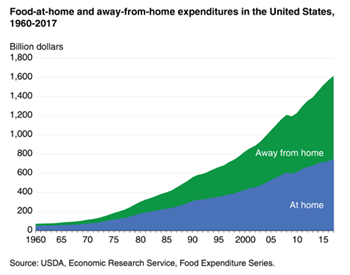There was a time when food was sold through much more rigid channels than exist today. For the most part consumers used to buy their meats, dry groceries and fresh food at a supermarket and when they had extra income to splurge on “out of the house” food they would drive to a restaurant in their community. But channels have been blurred for quite a while now. The largest food retailer in the U.S. is Walmart and Americans are increasingly comfortable with buying food online.

In 1985 about 60% of food sales took place in the grocery aisle and about 40% of sales occurred in restaurants and other foodservice establishments. Today, spending at foodservice outlets accounts for more than half of the total $1.6 trillion in food sales, surpassing grocery retail by about 1%. The term “grocerants” initially referred to a supermarkets that offered in-store dining and fresh prepared foods that were ready to eat/ready to heat. Sometimes called “foodservice at supermarkets”, it was an attempt by grocery retailers to lure customers back by getting into the restaurant biz.
These days the term “Grocerant” has morphed into a trend that is centered on selling a retail food item that is ready-to-eat or ready-to-heat. What used to be a considered a competitive tactic for large grocers has become a trend that goes beyond the traditional grocery store. The rub against grocery stores making the most of the grocerant trend is that convenience stores, mass merchandisers, airports, websites, drug stores and pretty much any company that can package a meal solution that meets the needs of time-starved consumers can jump on the grocerant bandwagon.
Younger consumers seek out meal solutions and they care mostly about convenience and affordability. While the grocerant concept does offer a solution it competes with emerging grocery delivery companies, meal prep kits, online ordering, mobile apps and new store formats like Amazon Go. Just as channel lines have blurred over the past decades, we expect the line between retail foodservice and restaurants will continue to blur. And that blurring will probably affected by some evolving technology that will change the industry landscape in ways that can’t easily be foreseen.

